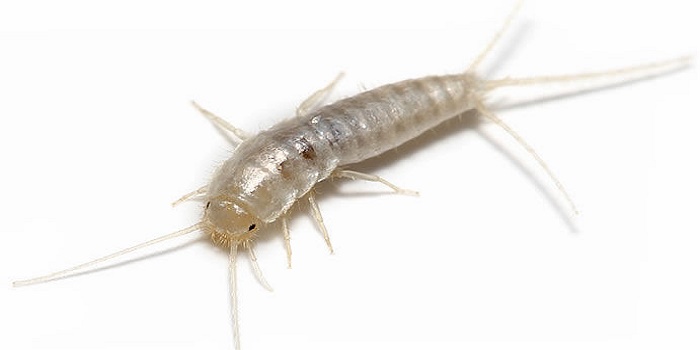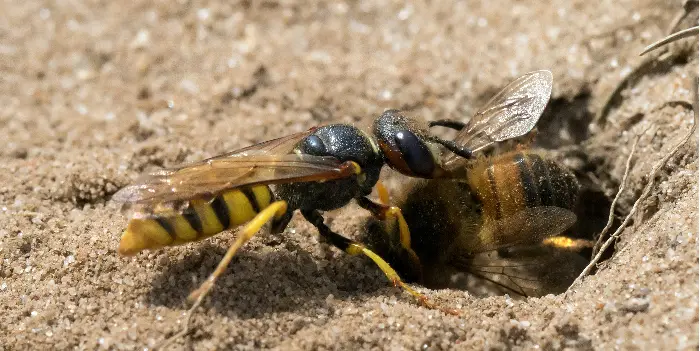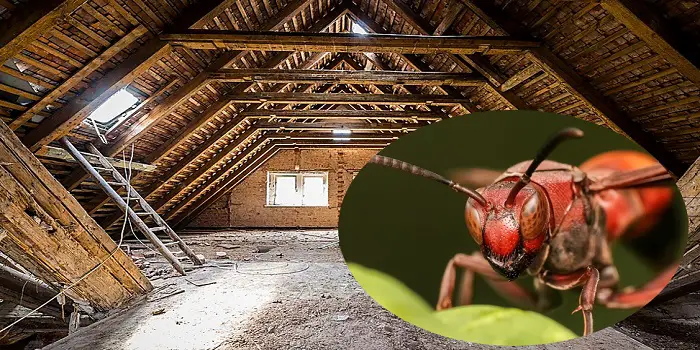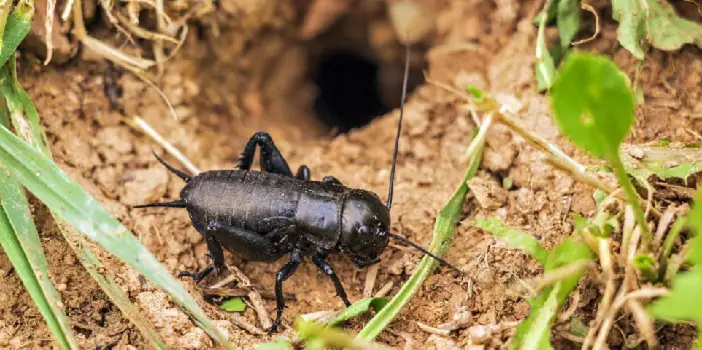
The firebrat is a small insect that is distinguished by its three slender, hair-like tails that extend from the back of its body.
It also has a long pair of antennae at the front.
Sometimes called bristletails, the firebrat is carrot-shaped, grayish-brown, and has dark spots along its back.
And while they cannot fly, they can move around surprisingly quickly, given their long tails and antennae.
The firebrat is most commonly found in hot and humid areas, particularly dark ones.
They mostly consume molds or starchy foods, so they can often be found in the kitchen of many homes.
But the question is, are firebrats a threat to you, your family, and your pets?
Why Do You Have a Firebrat Infestation?
The reason you have an infestation of firebrats and the level of infestation in your apartment varies depending on the environment.
Firebrats prefer hot, humid areas with temperatures that soar above 90 to 100 degrees F.
This makes bakeries, boiler rooms, water heaters, and pipes prime locations for the firebrat to call home.
The pipes in your home are a highway system for the firebrat to scurry about to their food sources.
You will often find firebrat nests near water heaters, inside walls, behind baseboards, and even in bookcases.
But a typical firebrat will be attracted to the heat and moisture found near your bathtub.
Many firebrats will drown when seeking out such humid and hot areas.
Outdoors and firebrats tend to nest under bark, leaf molds, or rocks. You can even find them in the nest of birds or mammals.
It is often through one of three ways if they decide to enter your home.
- Roof with a crack or hole
- Sinks with cracks or openings
- Showerheads that are broken or damaged
The more clutter inside your home, the more likely firebrats may be.
Inside the cardboard boxes and shipping containers, you may find nests of firebrats present.
In fact, one of the most common ways that a firebrat will find its way inside a home is within a container of books, paper, or furniture as it is being moved inside.
But unless you see a firebrat or several firebrats, how do you know if they have made your apartment their home & how do you get rid of them?
Ways to Getting Rid of Firebrats in Your Apartment
Fortunately, there are several ways to get rid of firebrats.
You can call an exterminator, but if you want to save money, you can try any of these methods first.
1- Swatter
Although firebrats can scurry about, they do not have good reflexes.
This means that they will often stay still when discovered.
At least until they gather their wits and take off.
It is during that time you can swat them with a fly swatter.
However, just about any light item such as a rolled-up newspaper, book, or other items will work.
The only problem is that while you can kill some in this manner, you are not directly addressing the issue of firebrats in your apartment.
2- Cold
Cold temperatures make the firebrats sluggish, and freezing temperatures will kill them instantly.
So, to get rid of firebrats, apparent vacuum the rooms and keep the air conditioner running in its coldest setting.
If the infestation is more at a specific place like a box, you can keep it inside the freezer for 2-3 days.
The cold from the freezer will naturally kill the firebrats and their larvae.
3- Traps
Simple sticky tape is a great way to catch firebrats, cockroaches, and other small insects.
The tape is made of paper products, so it will instantly attract firebrats.
After placing them in areas frequented by the insect, just replace the sticky tape when needed.
Alternatively, you can create a more natural version of a sticky trap by using flour and water.
Make a paste by mixing flour and water. Then spread it onto a piece of cardboard, allow some time to dry, and use it to capture the pests naturally.
4- Natural Remedies
If you prefer clearing the firebrats in your home with natural home remedies, there are a few of them you can try.
Some of the most common ones include:
- Cedar oil or shavings
- Citrus fruit peels
- Cinnamon and cloves
- Cucumber peels
- Table salt or boric acid
You can spread/sprinkle one of these substances near the infested areas – the strong scents of these products will help deter the firebrat bugs fast.
Sprinkling table salt or boric acid will especially work when firebrats consume them. These will eventually lead to their fatal dehydration.
5- Pesticides
One of the more common ways is to spray an insecticide around the places you suspect the firebrats are feeding.
However, unless you are going to move your food away from such areas on a long-term basis, then a pesticide is not desirable.
In fact, you may be creating an even bigger issue with the poisons used in the insecticide than the firebrats themselves.
IMO you should therefore use pesticides in your apartment only when the above nature fails to stop the infestation.
How Serious are Firebrats?
The presence of a firebrat can make you feel uneasy.
Their fast movement, combined with stopping and starting suddenly, can startle even the bravest of souls.
The firebrat itself does not bite, nor does it spread disease. They also do not have stingers, fangs, or venom glands.
This means they are neither poisonous nor very dangerous for humans.
However, it will contaminate food sources such as flour, cereals, and other food that contains proteins and sugars.
Paper is also a favorite food source, which means that firebrats are a threat to books, newspapers, and any item made of paper.
But if you see a firebrat, identifying its food source may be problematic since they often move considerable distances during the day.
However, you can bet that if you see one inside your home, the kitchen and any room with paper in it are prime food sources for the firebrat.
What are the Signs of Firebrat Bugs Damage?
Firebrats are generally too careful to be seen in broad daylight.
For the most part, you may not see them at all unless you enter a dark room and turn on the light.
If they are distant, their unique scurrying manner, which consists of sudden starts and stops, is a giveaway that they are firebrats.
Few other signs which tell you about the presence of these insects include:
a) Small, Chewed Holes:
The most common sign of firebrats is the damage they cause.
Most notably, the holes are chewed into books, papers, and starchy foods.
Even book bindings and linen are subject to firebrats.
If you see small holes in such items, especially when they go straight through, you probably have a firebrat infestation.
b) Fecal Matter:
The waste product of firebrats may collect in the sink or tub as they crawl around looking for some water to drink.
However, if they find their way inside the tub, then getting out is problematic for them.
So, if you see their fecal matter but no firebrat, it probably died inside the drainage pipe.
Of course, you may also find their small, pepper-like fecal matter on shelves, books, and other items near where they feed.
c) Molted Skin:
A typical firebrat will live up to four years. That will molt quite often during their lives.
So, this means that you may find their old skin in places where they like to nest or frequent.
Under appliances, on bookshelves, or in hot, moist places is where they are most likely to molt.
If you see any of these signs, you have a substantial firebrat infestation.
For every one you see, there may be dozens more lurking in your apartment.
How Can You Prevent Firebrats from Coming Back?
Once you get rid of the firebrats, the next step is keeping them from re-entering your apartment in the future.
You can do this by putting all non-perishable foods into a hard container that can be fully sealed.
Other methods include removing food from any area that is moist and hot.
And finally, giving the apartment a good cleaning while installing air purifiers.
Because firebrats operate mostly off their sense of smell, removing the odors of food will often confuse and even turn them away if they are searching for something to eat.
You will need to be persistent in your prevention efforts, but a little work today can help prevent firebrats from coming into your home tomorrow.
Other Related Questions:
Can firebrats climb?
Although firebrats have six legs, they aren’t good climbers. They can, however, jump sideways when threatened.
Unlike many other insects like spiders, they are also not very quick when climbing vertically on surfaces like walls.
In fact, if it’s a smooth surface (like a ceramic sink or a glass window), it’s nearly impossible for these bugs to climb.
And that’s the reason it’s easy to catch and trap them in glass jars.
Why are they called Firebrats?
The firebrats are typically white with a few light and dark spots. Adults are roughly 10 mm (0.39 inch) in length.
The reason they are named “firebrat” is because of their attraction towards heat, due to which they most like to live and eat in warm/hot areas.
Are firebrat and silverfish the same or different?
It’s not uncommon to mistake firebrats and silverfish for one another.
Although both of them are closely related, they are different insects where the key differences lie in their appearance and habits.
Where silverfish appears to be solid silvery or gray metallic in color, firebrats are more brownish to gray mottled color.
Another main difference between silverfish and firebrats is in the spaces they tend to occupy.
Firebrats like to thrive in hot temperatures (generally between 98° F. and 102° F).
Whereas silverfish will mostly prefer damp, humid areas of the homes with temperatures between 70°-80°F.
The conclusion
Although not very dangerous, firebrats are a nuisance if they enter apartments, bakeries, and commercial kitchens.
Because of their diet, they can even damage paper and clothes.
Hopefully, the above few tips on identifying them and how to deal with them naturally can help you get rid of them pretty fast.
Share the post "How to Get Rid of Firebrats in Your Apartment – Naturally"

Welcome to ProShieldPest.com. I am Tina Jones. I have been working as a pest removal professional in Winslow, Arizona lately. At present, I love to spend my time with my family as a retiree.
Here I share all my knowledge and experiences to help people understand better how they can stop pests at their homes without actually killing them. Hopefully, the information you will find here will help in safeguarding your home! You can check more about me here.




